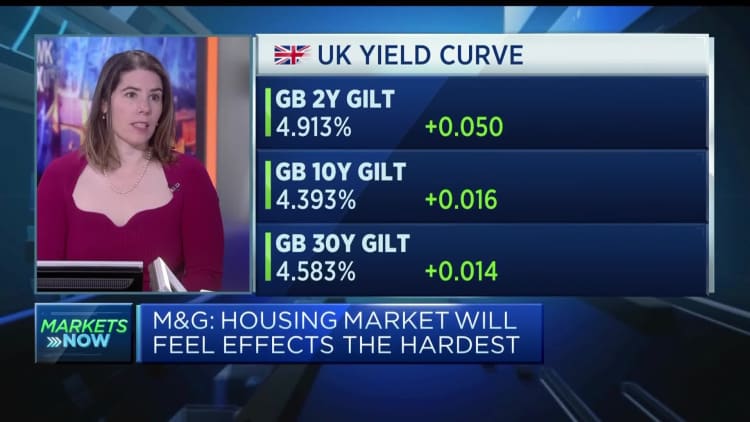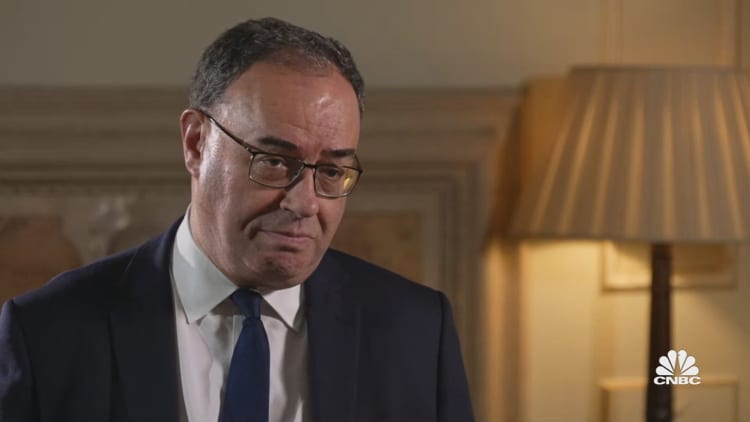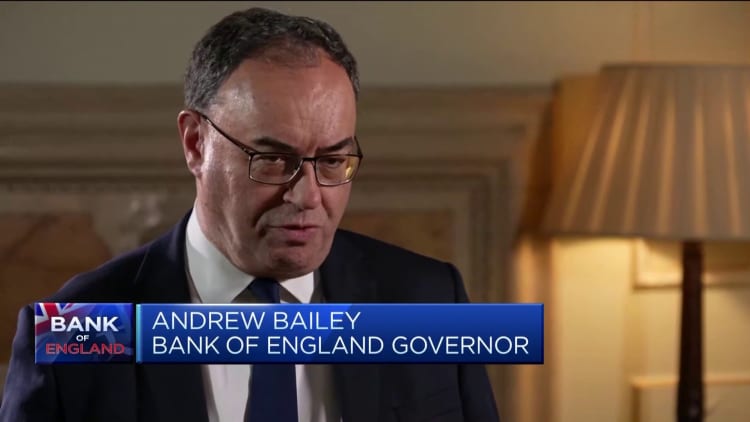A member of the public walks through heavy rain near the Bank of England in May 2023.
Dan Kitwood | Getty Images News | Getty Images
The Bank of England’s losses on bonds purchased to support the U.K. economy following the financial crisis are expected to exceed projections until the middle of the decade, according to Deutsche Bank.
In its late July estimates, the central bank indicated that the U.K. Treasury would need to backstop £150 billion ($189 billion) worth of losses on its asset purchase facility (APF).
The program, which ran from 2009 to 2022, aimed to improve financing conditions for companies impacted by the 2008 financial crisis. During this period, the Bank of England accumulated £895 billion in bond holdings due to historically low interest rates.
However, the central bank initiated the unwinding process in late 2022, starting with halting reinvestments and then actively selling bonds at an expected rate of £80 billion per year from October 2022.
Both the Treasury and the Bank of England were aware that the APF’s initial profits (£123.8 billion as of September last year) would eventually turn into losses as interest rates increased.
However, the rapid tightening of monetary policy to curb inflation has led to sharper-than-anticipated costs. As interest rates rise, the value of the government bonds, also known as gilts, purchased by the Bank of England has decreased, resulting in losses during the bond sales.

According to July’s public finances data, the Treasury transferred £14.3 billion to the Bank of England during the month to cover losses related to its quantitative easing program, exceeding the independent Office for Budget Responsibility’s March projection by £5.4 billion.
Deutsche Bank’s senior economist, Sanjay Raja, highlights that £30 billion has been transferred from the Treasury to the central bank since September, and indemnities are expected to continue exceeding the government’s forecasts for two reasons.

“First, interest rates have risen far above the levels assumed in the fiscal watchdog’s spring forecasts. Second, gilt prices have fallen further, particularly in the longer end of the curve, resulting in additional valuation losses as the Bank actively unwinds the APF through gilt sales,” notes Raja in a research note on Friday.
With 14 consecutive interest rate hikes, the Bank of England has increased its benchmark interest rate from 0.1% in late 2021 to a 15-year high of 5.25%. The market generally expects a fifteenth hike to 5.5% at the next Monetary Policy Committee meeting.
A twofold impact
Imogen Bachra, head of U.K. rates strategy at NatWest, explains that the impact on public finances and the government’s coffers is twofold.
“On one hand, quantitative tightening (QT) incurs losses because the Treasury bears the Bank of England’s losses when gilts are sold at a lower price than purchased. This was expected since the Bank of England bought bonds when rates were falling due to deflation, with the definition of ‘success’ being reflation and higher rates,” Bachra noted in a recent analysis.
“On the other hand, while QE gilts are not sold, the Bank of England pays Bank Rate on the approximately £900 billion reserves it created to make the purchases. As Bank Rate rises, this interest expense becomes more costly,” added Bachra.
This situation could impact the government’s ability to make public spending commitments or offer tax cuts in the run-up to the scheduled 2024 general election.
Any profits generated by the Bank of England from printing banknotes or buying and selling bonds, beyond its required capital buffers, are transferred to the Treasury for public spending purposes.
‘Ballooning cost’
Deutsche Bank analyzed both the net interest costs likely to be paid on central bank reserves and the declining value of APF bonds when the Bank of England realizes the “mark-to-market” losses by selling or redeeming them.

Raja concludes that the Treasury’s cost of indemnifying the central bank over the next two fiscal years will be approximately £23 billion higher than the OBR’s forecast in March. This amounts to £48.7 billion for the current fiscal year and £38.1 billion for the next year, with a sharp decline over the following two years as the bank rate decreases and the size of the APF stock diminishes.
“Not only is inflation higher than expected, but the indemnity cost of the Bank of England’s balance sheet operations will almost certainly be greater than what was predicted just five months ago,” Raja stated. He added that this additional burden on the government’s debt servicing bill will be reflected in Finance Minister Jeremy Hunt’s autumn budget statement.
“The positive news is that overall borrowing will likely fall short of the OBR’s forecasts heading into the autumn fiscal statement due to stronger government revenues resulting from a stronger economy over the past few months. This will mask the increasing cost of the Bank’s APF bill,” Raja concluded.
Denial of responsibility! VigourTimes is an automatic aggregator of Global media. In each content, the hyperlink to the primary source is specified. All trademarks belong to their rightful owners, and all materials to their authors. For any complaint, please reach us at – [email protected]. We will take necessary action within 24 hours.


